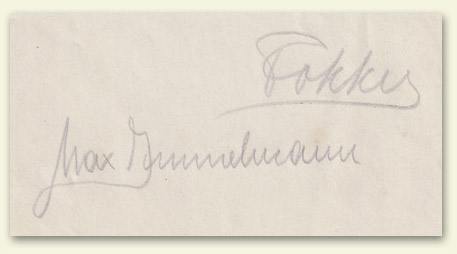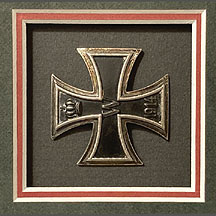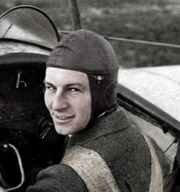

The Fokker Scourge
- Max Immelmann & Anton Fokker - with an original drawing by Russell Smith -
This specially commissioned original drawing by Russell Smith depicts legendary Ace Max Immelmann scoring his first victory, a BE2c on Aug 1st. 1915. Flying his early production model Fokker E.1 (Eindecker) he followed the stricken aircraft down and eventually landed next to it to check on the crew. |
| Overall size: 17½" x 19¾" | Image size: 8" x 13" |
| Museum presentation | Original drawing - Max Immelmann & Anton Fokker signatures & WWI Iron Cross 1st. class. |
| SOLD | ||
 |
Almost all old signatures are found on paper that has discolourd and or darkened through age. Over the last 100 years or so this example has acquired a mellow colour, but is in very good condition. Vintage signatures are found signed in a variety of ways, including in grease pencil, graphite pencil and ink. This particular piece was signed with a regular graphite pencil and exhibits no fading. The signatures look the way they must have done in late 1915 or early 1916. |
|
_NEW |
||
|
Iron Cross First Class Included in the mount is this original First World War Iron Cross 1st Class. The medal has a pin back which was used to faclitate mounting, no glues were used or alterations made in this process. |
|
 Max Immelmann Max ImmelmannMax Immelmann was born on 21 September 1890 in Dresden, to an industrialist father who died Two very early examples of the Fokker Eindecker fighters were delivered to Immelmann’s unit, Immelmann was one of the first German fighter pilots, quickly building an impressive score of air victories he flirted with the position of Germany's leading ace, trading that spot off with Oswald Boelcke. Immelmann was the first pilot to be awarded the Pour le Mérite, Germany's highest military honour, receiving it on the day of his eighth victory, 12 January 1916. The medal became unofficially known as the "Blue Max" in the German Air Service in honour of Immelmann. His medal was presented by Kaiser Wilhelm II on 12 January 1916. Oswald Boelcke received his medal at the same time. In the late afternoon of 18 June 1916, Immelmann led a flight of four Fokker E.III Eindeckers in search of a flight of eight F.E.2b fighter/reconnaissance aircraft of 25 Squadron Royal Flying Corps over Sallaumines in northern France. The British flight had just crossed the lines near Arras when Immelmann's flight intercepted them. After a long-running fight, scattering the participants over an area of some 80 square kilometres Immelmann brought down one of the enemy aircraft, wounding both the pilot and observer. This was his 16th victory claim, though it went unconfirmed. At 21:45 that same evening, Immelmann encountered No. 25 Squadron again, this time near the village of Lens. Immediately, he got off a burst which hit RFC Lt. J. R. B. Savage, pilot of F.E.2b pusher serial 4909, mortally wounding him. This was his 17th victory claim, though Max Mulzer was later credited with the victory. The second aircraft he closed on was piloted by Second Lieutenant G. R. McCubbin. McCubbin was credited by the British with shooting Immelmann down during this encounter. On the German side,
many had seen Immelmann as invincible and could not conceive the notion that he had fallen to
enemy fire. The German Air Service at the time said the loss was due to friendly anti-aircraft fire. Others,
including Immelmann's brother, believed his aircraft's gun synchronisation had malfunctioned
with catastrophic results. Early versions of such gears frequently malfunctioned in this way and
this had happened to Immelmann twice before, although on each occasion he had been able to
land safely. |
 Anton Fokker Anton FokkerAnton Herman Gerard Fokker was born in Blitar, Dutch East Indies (now Indonesia), to Herman
Fokker, a Dutch coffee plantation owner and Johanna Hugona Wouterina Wilhelmina Diemont.
When he was four, the family returned to the Netherlands and settled in Haarlem in order to
provide Fokker and his older sister, Toos, with a Dutch upbringing. Fokker's interest in flight stemmed from Wilbur Wright's exhibition flights in France in the summer and fall of 1908. In 1910, aged 20, Fokker was sent by his father to Germany to receive training as an automobile mechanic, but his interest was in flying, that same year Fokker built his first aircraft "de Spin" ("the Spider"), which was destroyed when his business partner flew it into a tree. He gained his flying certificate in his second "Spin" aircraft, which shortly thereafter was also destroyed by the same business partner, prompting Fokker to end their cooperation. In 1912, Fokker moved to Johannisthal near Berlin, where he founded his own company. At the outbreak of World War I the German government took control of the factory. Fokker remained as director and designer of many aircraft for the Imperial German Army Air Service, including the Fokker Eindecker and the Fokker Dr.I, the triplane made famous in the hands of aces such as Manfred von Richthofen. In all, his company delivered about 700 military aircraft to the German air force as well as supplying the German navy and Austria-Hungary. Fokker himself was a skilled pilot, demonstrating his aircraft on many occasions. On 13 June
1915, Fokker demonstrated the new Eindecker at Stenay in the German 5th Army Sector in front
of the German Crown Prince and other VIPs. Max Immelmann, later to become a high-scoring
flying ace with the Eindecker, commented in a letter written shortly after this event that:
"Fokker, especially, amazed us with his skill". Fokker's Dutch and American companies were at the peak of their success in the late 1920s, but
he lost control by going public to sell stock. In 1929, General Motors took over Fokker Aircraft
Corporation of America, and merged it in the General Aviation Corporation. Fokker was
appointed director of engineering but resigned in 1931. Fokker designs were increasingly
outdated and in 1934 General Aviation discontinued their production. Fokker died in 1939 in New York at the age of 49. |